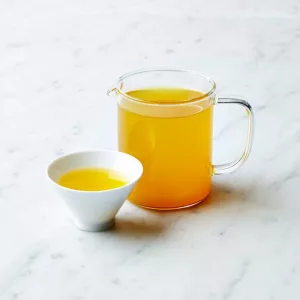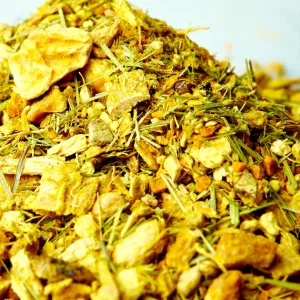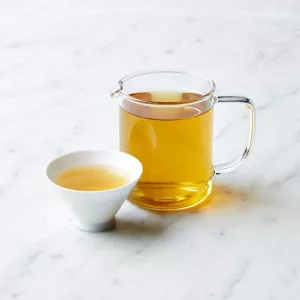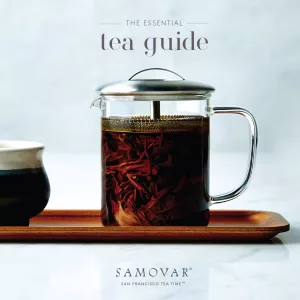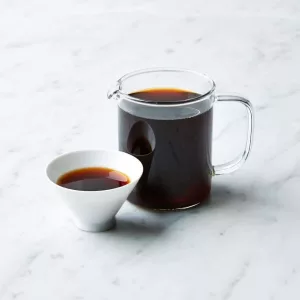©2009 Jennifer Leigh Sauer

Samovar Tea Lounge has many attributes that bring people to its three locations and keep them returning for more.
Its success has also invited a few critics, who complain about paying $10 or $12 for a pot of tea.
As a fan of high quality tea and of Samovar Tea Lounge, I feel an inclination to gently dissect and explore the difference between buying a “specialty tea” that you prepare and drink at home, and having a connoisseur level tea prepared for you at a tea lounge like Samovar. The goal is not to scold, certainly, but to inform, gladden, and engage you in a new way of understanding tea.
First, what is the difference between “specialty” tea and connoisseur quality tea? You can find a “specialty tea” on a supermarket shelf. It will be nicely packaged (which increases the carbon footprint of the tea), usually contain nylon teabags (ditto), and be filled with content that costs about two to three cents per serving, at most. You will pay around $5-$15 for a fancy box or tin of 12 teabags. Most of what you will find in the specialty teabag is not tea at all, but dried bits of flowers, spices, fruit and rind–stuff you can find in your own garden or kitchen cabinets.
Specialty tea is almost always machine processed and manufactured by corporations. It is picked by machine, processed by machine, and packaged by machine. You will take your $10 box of teabags home and drink it in a safe and familiar environment, your home. It will taste good. You will have as many servings as there are teabags, namely twelve.
Now compare this to the experience you will likely have at Samovar Tea Lounge, sipping a connoisseur quality tea. The Samovar tea you are sipping is likely hand picked, processed by a craftsman whose whole life has revolved around tea, and often organically grown. Centuries of experimentation have gone into the careful crafting of the tea. It has been selected personally by Samovar owner Jesse Jacobs, who looks for the highest quality teas. Once arriving in the United States, the tea is properly stored in the Samovar warehouse to preserve its freshness and unique characteristics.
The tea you are drinking will not be available next fall or next spring. In fact, it will never be available again, once the Samovar stash has run out. It is inimitable, evanescent, a measure of climate, soil, and heaven passing through plant matter and skilled human hands. How could such a tea be the same year to year? Where specialty tea manufacturers strive for uniformity, connoisseur tea proprietors relish the unique and transitory nature of the teas they find and sell.
Besides just sipping this level of tea, you will find yourself in a uniquely beautiful setting that makes you feel both at home and embraced by community. It is neither Asian nor western, but something in between, familiar and exotic at the same time.
Next, a human being who cares about nothing more than pleasing you and meeting your needs will offer you a menu and any advice about the teas that are offered. This human will have excellent knowledge of Samovar’s selection of teas: where they come from, how they were processed, their seasonality, and with what foods they pair best. She will educate you on tea and tea culture, if you ask.

You will choose a loose leaf tea (low carbon footprint), which will be expertly steeped for you and served in a vessel reminiscent of the country of origin of the tea.
You will be fully engaged and relaxed, enjoying the ambiance and fine service, as well as the art, the fun tea people, the beautiful teaware, and the music. You can stay as long as you like.
In fact, you may as well stay a while, because your connoisseur quality tea is capable of a good many steepings that will produce four to ten servings (at least) of exceptional tea– which you can drink by yourself or share with a friend.
Now comes the bill. If you have the tea soup (a meal in itself to be sure) and a pot of artisanal Japanese Hojicha- a delicious rich and roasted green tea, that makes you feel like you are dancing between planets—your bill will come to approximately $12, including tax. No one will ask you to remember to clear the table and do the dishes when you are finished.
And remember, you didn’t have to do the grocery shopping or cook either. In fact, the server will ask you if everything was to your liking, if you enjoyed the tea so much that you’d like to take some home with you, and when you’ll be back again. Twelve little clams.
Can you buy a $50 pot of tea at Samovar Tea Lounge? Yes. And that is good. It means that you are in an establishment that has teas so rare and fine that they fetch a handsome price—not only in the tea lounge, but at auction in Asia where the tea was grown and crafted. You are not being charged $50 for a pot of tea from a teabag found in grocery chain store that is filled with bits of orange rind and low grade tea.
You are being charged for a tea that will never come this way again. Ever. It will be rare, refined, something you have never tasted before and never will again. At $50 this is a bargain. At $12, it is a steal, particularly when it comes with a delicious meal.
In other words, you are not paying for a teabag. You are paying for an opportunity that only a rare few people in the world get to experience. Tasting and learning about connoisseur quality teas and being served these teas by people who are trained to properly brew and serve it—well, that is something pretty special that you will never find on the shelf of a supermarket, guaranteed.
In fact, just 15 years ago, you had to go to Asia to have such an experience. But now, for a mere $12, you will be cooked for, pampered, served, educated, relaxed and relieved of the angst you brought in with your monkey mind when you walked through the door.
So, people, pu-leeeease don’t complain about a $5 or even $50 pot of tea or a spectacular meal of fresh ingredients prepared with kindness and attention to detail that costs $12. Give thanks to the people who gave you the experience: the server, the tea farmer, the tea processor, the tea merchant, the cook, the dishwasher, the interior designer, and musicians. Arrive giving thanks. Leave giving thanks. Always.
– Jennifer for Samovarlife
Jennifer Leigh Sauer, is a freelance photographer, award-winning video journalist, and author based in the San Francisco Bay Area. She is the author of The Way to Tea: Your Adventure Guide to San Francisco Tea Culture (2007). Click here to reach her by email.

